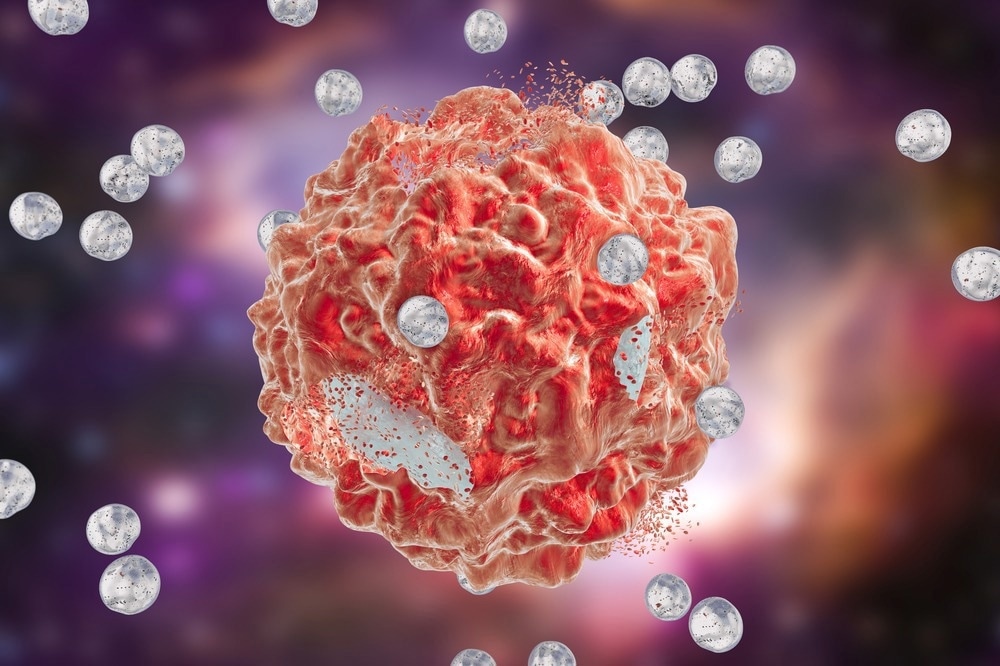In a recent review article in Life Sciences, researchers from India, the UK, and the USA highlight advancements in using nanomaterials to induce ferroptosis in cancer cells, focusing on molecular dynamics and innovative cancer therapy strategies. By leveraging the unique properties of nanomaterials, they aim to enhance cancer treatments and overcome traditional therapy challenges.

Image Credit: Kateryna Kon/Shutterstock.com
Ferroptosis, a form of iron-dependent cell death, has emerged as a promising avenue for cancer therapy due to its ability to selectively target cancer cells while sparing normal cells. Understanding the relationship between ferroptosis, reactive oxygen species (ROS), and lipid metabolism is crucial. Nanomaterials offer precision and efficiency in delivering therapeutic agents to induce ferroptosis in cancer cells.
Studies Highlighted in this Review
Numerous studies have explored the potential of nanomaterials in inducing ferroptosis in cancer cells, showcasing remarkable advancements in cancer therapy. One notable study focused on the development of gold nanoparticles loaded with specific microRNAs (miRNAs) to target and induce ferroptosis in breast cancer cells.
The miRNAs encapsulated within the gold nanoparticles were designed to downregulate key anti-ferroptotic proteins, thereby sensitizing the cancer cells to ferroptosis induction. This approach demonstrated enhanced cytotoxicity towards cancer cells while minimizing off-target effects on healthy tissues.
In a separate study, lipid/polymeric nanoparticles were engineered to deliver small interfering RNA (siRNA) targeting crucial genes involved in the ferroptotic pathway in pancreatic cancer cells. The nanoparticles efficiently delivered the siRNA payload to the tumor cells, leading to the suppression of key proteins responsible for ferroptosis resistance.
This targeted gene-silencing approach significantly reduced tumor growth and enhanced sensitivity to ferroptosis-inducing agents, highlighting the potential of nanomaterial-based gene therapy in cancer treatment.
Another study explored the use of iron-based nanomaterials to enhance the Fenton reaction within cancer cells, thereby promoting the accumulation of ROS and triggering ferroptotic cell death. By modulating the iron content within the nanoparticles and optimizing their physicochemical properties, the researchers achieved precise control over ROS generation, leading to the selective eradication of cancer cells while preserving normal tissue integrity.
This strategy demonstrated promising results in various cancer models, underscoring the versatility and efficacy of iron-based nanomaterials in ferroptosis induction.
An additional study investigated the development of multifunctional theragnostic nanoplatforms for cancer management by integrating nanoparticles with diverse functional properties. These nanoplatforms combined the therapeutic potential of ferroptosis induction with diagnostic capabilities, such as imaging properties and magnetic hyperthermia effects. The synergistic effects of these multifunctional nanomaterials facilitated precise tumor targeting and enabled real-time monitoring of treatment efficacy, paving the way for personalized cancer therapy approaches.
Overall, the studies highlighted in this review collectively demonstrate the versatility and potential of nanomaterial-mediated ferroptosis-induced cancer therapy. By leveraging the unique properties of nanomaterials to target specific molecular pathways involved in ferroptosis, researchers are advancing toward more effective and personalized cancer treatment strategies that promise to improve patient outcomes and revolutionize the oncology field.
How Are Nanopores Used in DNA Sequencing Applications?
Findings and Discussion
Research has demonstrated the effectiveness of nanomaterial-mediated ferroptosis-induced cancer therapy in various cancer types.
Nanoparticles with multifunctional properties, including photodynamic, photothermal, and magnetic hyperthermia effects, have shown potential for synergistic cancer management. The physicochemical properties of nanomaterials also play a crucial role in dictating their therapeutic efficacy.
Iron-based nanoparticles, for instance, can modulate the Fenton reaction within cancer cells, leading to the generation of ROS and subsequent ferroptotic cell death. By fine-tuning the iron content and surface characteristics of these nanoparticles, researchers can achieve selective cytotoxicity toward cancer cells while minimizing damage to normal tissues.
The development of multifunctional nanoplatforms represents a cutting-edge approach to cancer management. These nanoplatforms integrate therapeutic and diagnostic functionalities, enabling real-time monitoring of treatment efficacy and precise tumor targeting.
By combining ferroptosis induction with imaging properties, magnetic hyperthermia effects, or other modalities, researchers can create synergistic treatment strategies that enhance therapeutic outcomes and patient care.
Understanding the molecular mechanisms underlying ferroptosis and its regulation in cancer cells is crucial. By elucidating the intricate interplay between ROS, iron metabolism, lipid peroxidation, and cellular signaling pathways, researchers can identify novel targets for ferroptosis induction and develop tailored nanomaterial-based interventions for specific cancer types.
Conclusion
Significant progress has been made in utilizing nanomaterials for ferroptosis-induced cancer therapy. This research underscores the potential of nanomaterials to revolutionize cancer treatment by targeting specific molecular pathways involved in ferroptosis.
Continued research efforts are essential to overcome existing challenges and optimize the use of nanomaterials in cancer therapy. The integration of technologies from various disciplines holds promise for developing innovative strategies that can enhance the efficacy of ferroptosis-induced cancer treatments and improve patient outcomes in the future.
Journal Reference
Namdev D., et al. (2024). Recent advancements in nanomaterial-mediated ferroptosis-induced cancer therapy: Importance of molecular dynamics and novel strategies. Life Sciences. doi.org/10.1016/j.lfs.2024.122629